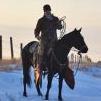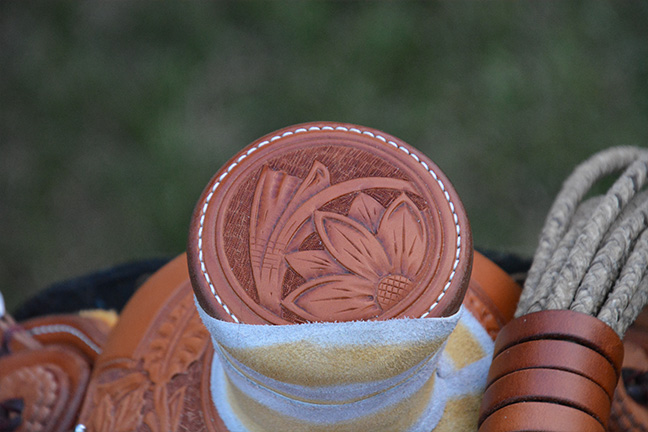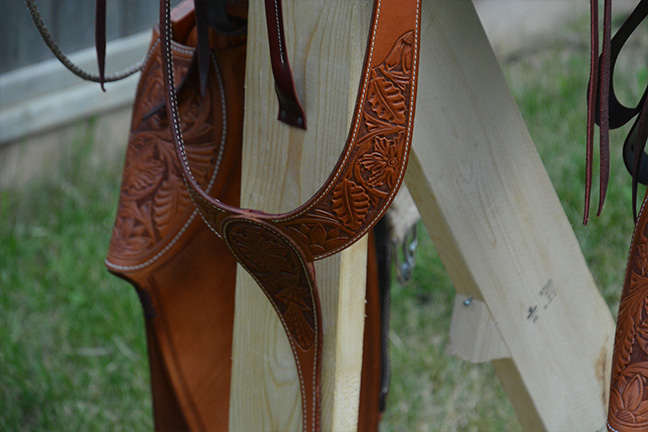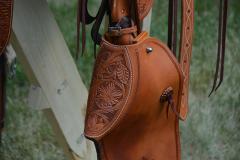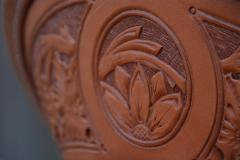-
Posts
366 -
Joined
-
Last visited
Content Type
Profiles
Forums
Events
Blogs
Gallery
Everything posted by rdl123
-
Hello Paulamoose, I am self taught as well - Once again because of limited time and the inability to take time to go away to saddle making school. Here is my advice: Be careful where you look to for direction. There are saddle makers and there are Saddle Makers if you know what I mean. Al Stohlman's stuff is OK - He complicates things a bit in my opinion but his books are a good resource - I have them and refer to them on occasion. Jeremiah Watt's DVD's are excellent - He makes fitting the seat super simple - I refer to these DVD's all the time Dale Harwoods dvd's are well worth the investment - I refer to these DVD's all the time I have looked at Dusty Johnson's website - I find that his saddles do not have attractive lines and generally look unattractive. I would be careful what I took from his DVD's as I would not want my saddles to look like his. This is just my opinion though. Here are makers who make saddles that I find well designed and attractive: Mike Keetch Steve Mason Dale Harwood Keith Seidel Gordon Andrus I spent a lot of time looking at pictures on the internet of saddles I thought were well designed before I started. There are certain principles that apply to saddle design that you will see these makers use and it creates a nice looking, balanced saddle every time. Materials: Use good materials I recommend Hermann Oak leather. It lasts and lasts - Wickett & Craig will wear out a lot faster. Use only a good tree maker. I would use Sonny Felkins (Quality Tree MFG.) His Northwest bars have worked well for me. Use only stainless steel or brass hardware. No nickel plated junk. Before I built a saddle I built and hand stitched a rear cinch to see if I had the patience for all of the hand stitching required for a saddle. With leather i have found that slower is better. If i find myself getting in a rush I stop. Leather working, like horsemanship, requires (in my opinion) timing & feel. The leather has to have just the right moisture content. I believe good tools are important. I would rather have a handful of good tools over a bunch of cheap tandy stuff. Spend the money on a good round knife - Bruce Johnson can hook u up. Good Awls and awl handles are important Barry King stamps are very good. I do use Tandy's cheap punches as I find even expensive punches chip or dull quickly. I use a Cobra Class 4 sewing machine - It is easy to run and works great. Here is pictures of my progression to date: Saddle 01 Saddle 02 Saddle 03 Saddle 04 I hope this helps. Big thing is to have fun and take your time!! I strongly believe in learning how to make your own patterns as it helps you to analyze saddle design and mechanics. I made all my own patterns for these saddles and the goal is to continually refine them. Regards, Ron Lennox
-
Hello All, Here is saddle project #4 - This is a slick fork saddle I built for a friend on a Swanke tree. Finished out at 15.5" seat. 4.5" handhole w/90 degree bars. As per usual by this stage of project all I see is problems & mistakes. I'd be very glad of input from other saddle makers as my goal is to improve my work continually/ My tooling is still very amateurish. Trying to develop my own style but it seems to require a lot of practice! Looking forward to hearing critiques and input! Regards, Ron L
- 26 replies
-
From the album: Saddle #4
This is the fourth saddle I have built. Swanke tree, all Hermann Oak Leather. 15.5" finished seat. 4.25" handhole w/90degree bars -
From the album: Saddle #4
This is the fourth saddle I have built. Swanke tree, all Hermann Oak Leather. 15.5" finished seat. 4.25" handhole w/90degree bars -
From the album: Saddle #4
This is the fourth saddle I have built. Swanke tree, all Hermann Oak Leather. 15.5" finished seat. 4.25" handhole w/90degree bars -
From the album: Saddle #4
This is the fourth saddle I have built. Swanke tree, all Hermann Oak Leather. 15.5" finished seat. 4.25" handhole w/90degree bars -
From the album: Saddle #4
This is the fourth saddle I have built. Swanke tree, all Hermann Oak Leather. 15.5" finished seat. 4.25" handhole w/90degree bars -
From the album: Saddle #4
This is the fourth saddle I have built. Swanke tree, all Hermann Oak Leather. 15.5" finished seat. 4.25" handhole w/90degree bars -
From the album: Saddle #4
This is the fourth saddle I have built. Swanke tree, all Hermann Oak Leather. 15.5" finished seat. 4.25" handhole w/90degree bars -
The cantle back gets tooled on the bench. Usually I form it to cantle back, and then later, once it has formed I re wet it, flatten it back out and tool up. I am very amateurish at all of this - Some really good makers are Steve Mason, Cary Schwarz and Gordon Andrus... here is a pic of a saddle that I am just finishing up...
-
Hello Randy, I'm very green at this whole saddle thing...but from what I see here I sure see a lot of improvements as you have come along! I think this a good looking rig! The only thing that jumps out at me is that the edges could use rubbed/burnished a little more (I've had this issue on all my rigs too)... Saw something of Jeremiah Watt's the other day - he mentioned using Rublev brand Bone Glue Pearls...Mix 3tsp glue pearls in 1/2 cup warm water... then apply to edges only...and burnish out with soft flannel rag - Makes for flexible, deep brown edge... I think I am going to try this on next rig i'm working on as I struggle getting good, long lasting edges. Regards, Ron L
-
Company6, I am an amateur maker, largely self taught with major help from this forum and good educational DVD's. What i suggest below is how I went about it (more or less). This may not be the best way but I had limited spare time so it was my only option. Obviously apprenticing under a good maker would be the ultimate educational experience. Saddle making is a tedious, detail oriented deal - I recommend you try building some basic tack first. Build a set of chaps, a headstall, maybe some saddle bags. Try some smaller projects first and see if you enjoy the work. Smaller projects will build your confidence, ease you into the world of expensive leather tools, improve your coordination with leather tools and help you to get a feel for when skirting leather is cased 'just right' to tool / mold / cut etc. From there: a) look at as many pictures of good custom made saddles online as you can. Get an idea for what good lines on a rig look like vs/ bad ones (this is somewhat subjective), b)purchase educational DVD's and study thoroughly (Jeremiah Watt & Dale Harwoods DVD's are excellent), c) Buy Al Stolhman's saddle making encyclopedias, d) study as many good saddles as you can in person. See how they are built. Once you have a very clear picture in your mind of all that goes into a saddle you can decide if you want to tackle building one. From my experience: Buy a good custom tree, use only the best leather. Your first saddle will absorb a lot of time - May as well use good material. Here are some makers I draw inspiration from (there are many others too): Keith Seidel - http://www.seidelsaddlery.com/CustomSaddles/index.html Chuck Stormes - http://www.chuckstormes.com/ Freckers Saddlery - https://www.freckerssaddlery.com/ Steve Mason - http://www.stevemasonsaddles.com/ Chavez - http://www.rcsaddle.com/ Scott Brown - http://www.sabrownsaddles.com/ Ron L
-
Very nice Clyde! I really like the lines of your saddle as well as the shape of the ground seat - Looks like one you could spend a few days in! Do you order your rough-out leather pre-burnished from HO? Thanks - Ron
-
Very tidy workmanship Josh! Well done! Ron L
-
Nice job Mike - Ground seat shape looks good!
-
Thanks Josh & Old Coach, Built this one for me as I sold the first saddle I made for myself... Spent quite a bit of time in on it last weekend - So far no complaints - In skirt rig does get you closer to the horse. See how this one holds up but it seems to me like a good way to go - I like the lack of bulk under my leg. Here is saddle on a waspy little gelding we just started. Second image is of my first rig and this third one - Convincing some young ones to cross a bridge.
- 9 replies
-
- wade saddle
- inskirt
-
(and 2 more)
Tagged with:
-
Oltoot: That's a great idea...my lines do wander with this daisy stamp...I'll be investing in some 'rug runner'. Ideas like that are what make this forum so valuable! Ron: Thanks! The awl haft actually made a very sharp indent - I'll blame it on my Levi's! On the flank cinch dee - Yes - On this one I moved it back as I had an old hand tell me once it gives a little more leverage for holding a saddle down when roping big stuff if you get your rear dee back a bit...I agree that it looks nicer to have it just below and back of cantle point. I'd like to hear other's thoughts on this! I'm inclined to go back to positioning it a little farther forward then I did here... Rigging below seat jockey - Here is a mediocre pic - I'll try to take a better one showing sewing and added rivets... R
- 9 replies
-
- wade saddle
- inskirt
-
(and 2 more)
Tagged with:
-
-
Randy, As you know I am very green but have used Jeremiah Watt's technique on all three saddles. So far it has got me decent ear cuts that are tight and look OK. I find it simple to follow and that it has worked out every time so far. That said my experience base is v shallow... R
-
Thanks Randy, Got the daisy stamp from Jeremiah Watt...This is definitely the best ground seat I have put in so far - Went tin on this one and it's a little flatter side to side. Rode some colts this weekend and pin bones still feel fine! Saddle #4 starts right away here - I have ground seat in it already - So head start on it. It's a 3B (swanke again) and will have 24" eagle beak taps... Kind Regards, R
- 9 replies
-
- wade saddle
- inskirt
-
(and 2 more)
Tagged with:
-
IC - Then just pack it in with a hammer handle? Also - How do you like the Chahin leather - I've never tried it yet...Forms and tools nice? R
-
Very nice Josh - Do you pack these with hair or use the Jeremiah Watt forms? Thanks - R



